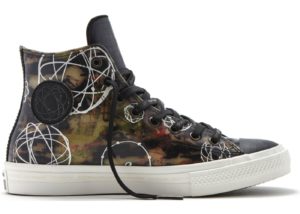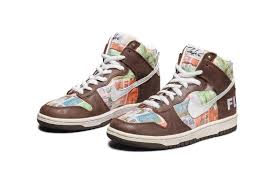Lavender blurs into yellow, then blue, into a sky-scape of oranges, triangles, and squares that intersect, overlap, and lineally tease each other. Horizontal lines bookending the top left and bottom right corners recall musical scales, while a black ribbon snakes across a plane of circles and rainbow checkerboards and a beige, black-rimmed sun hangs in the background.

This description—of Yellow-Red-Blue by Russian painter Wassily Kandinsky—could as well apply to the work of another pioneer of visual abstraction: Futura, street artist and creative collaborator extraordinaire. In Break (1980), one of his first seminal works—an entire subway car radiating layers of lemon, red, and Sunkist orange—the artist abandoned traditional graffiti graphics for soft explosions of shape and form. In slender script, the numerals “2000” repeat twice on the facade in reference to the New Yorker’s adopted surname.
Futura (born Lenny McGurr, and previously Futura 2000, dropping “2000” once the year 2000 had passed) earned his cred on the rails of New York in the 70s and 80s—a product of the same “subway school” of artists that carried Jean-Michel Basquiat and Keith Haring to instant acclaim. Futura opts for a lyrical, “free jazz” take on graffiti, as opposed to the bold block text and cartoonish figures typical of the era. His spray can whispers across a wall or canvas in loose, graceful arcs, layering mists of color in decisive, yet gentle, strokes.
With his breathy, gestural application of paint, Futura mingles a punk rock irreverence with Kandinsky-like reverence for the psychological and spiritual power of pure shape and color. The discipline evident in his lineography demonstrates what might be described as a lightness of wrist—a kinesthetic and visual 180 from the concept of “bombing” that distinguished the early years of graffiti and street art painting. Its bravado stems from straying from the expected mode of application.

But Futura’s departures from the expected aren’t just limited to his artistic style. He has historically been known for his willingness to depart from tradition, blurring the boundaries between street, gallery, and commercial collaboration. In a 2016 video of the artist painting a mural in Bushwick, Brooklyn, Futura carefully dots a blank wall with quick spurts of black spray paint—each creating the likeness up close of an inverted Gothic candy-corn, which from a distance resemble a curtain of ivy or leopard skin. “It’s a recreation of a pattern I made for a shoe,” he says, his lanky body balancing on a ladder midwinter. The shoe in question would be the Converse Skyfall, the canvas on which Futura’s black-on-white pointillism resembles comets crashing to the ground or rain upon a windowpane. Like graffiti legends Haze, ALI, and Stash, Futura has collaborated with footwear giants since the dawn of sneaker culture. “The break dancers—their shit always looked really correct and clean,” he reflects in Just for Kicks, a 2005 documentary on sneakers’ role in hip-hop. “It was all about keeping your sneakers pristine…that Ken Swift, rock-steady, b-boy look that made sneakers the main attraction to what you had on.”

Complementing his whimsical 2012 paint-splattered Hennessy label, a take on Converse Chuck Taylor All Stars from the same year spatter midnight-black with intense streaks of red, yellow, and white. In 2016, he adorned the exhibition and glass boxing for the Nike Air Force 1 Low “Linen” shoe debut at Miami Art Basel with a mural of abstract, whirling globes. In 2019, the translucent outsoles and insoles of his design for Off White’s Nike Dunk Lows echo the translucent sprays of paint applied to many of his fine art canvases. Perhaps his most notable — and certainly, as of press time, most valuable — shoe collaboration, however, was the extremely-limited edition Nike SB Dunk High ‘FLOM’ (an acronym standing for ‘For Love Or Money’) sneaker he designed in 2004, which boast a pattern of international currencies, in a rare departure from his usually more-abstract style.
Steadily cultivating his signature style over forty years of commercial and fine art experimentation, Futura demonstrates a range of influences that criss-cross countercultural realms like one of his signature elliptical orbitals. From live-painting The Clash’s stage backdrops in the early 80s to action-painting the pristine walls of Paris’s Colette boutique in 2015, Futura leaps between high and low as though jumping the cars of a moving train. Launching three exclusive, hand-painted designs for BMW’s M2 Competition in early 2020, the artist granted the luxury compact sports car a galactically badass splendor, both inside and out. “I was painting with power tools,” Futura explains, clad in a BMW jumpsuit at the Garching plant where the cars were created. “They’re glorified, industrial spray cans. You have to keep working the paint while it’s wet, which is perfect for me because I like to be spontaneous.” Watching the knit-capped 66-year-old earnestly geek out over the project makes it clear that commerce need not dilute creativity. A slender lightning bolt strikes the side of one design, like a nod to the energy of the artistic process itself.

Energy and matter are a recurring theme in Futura’s work, and a rare exception to his general lack of figuration. In keeping with his 80s acquaintance and downtown co-conspirator Andy Warhol, Futura took his inspiration for his recurring atomic rings from somewhere unabashedly mundane: a logo for a 1960s Johnson & Johnson label for Future Floor Wax. In 10 Color Recepie Exclusilly for Roy Chau… (1988), soft explosions of fuchsia, daffodil, and crimson are overlaid with a frantic galaxy of violet, blue, and seafoam green. More recent work, like Nacho (2015), privilege shape and form over color fields, arranging his avid atoms in red and black over a faded black-and-white atmosphere. For his 2019 solo show in Berlin, aptly titled The Five Elements, the artist exhibited over sixty new paintings exploring the macro- and micro-universe with equal esteem. Whether the Big Bang, the solar galaxy, or the whirring of electrons across invisible rings, matter matters to Futura, whose “2000” surname was originally a riff of Kubrick’s 2001: A Space Odyssey.
Across the decades, through space and time, for Futura, the boundary between the gallery and the street is as evanescent as his airy lines. “I think when you come from a section of society where there aren’t really any rules,” he told Interview magazine in 2015, “the scale and the size of things can’t be calculated. If you look at a blank canvas… and you’re required to work within the dimensions, that’s all the things that used to scare me. I’m not intimidated by that anymore.” A living testament to the merits of hustle meets humility, of street cred meets refinement, Futura is a New Yorker’s New York artist — with surging global influence.

